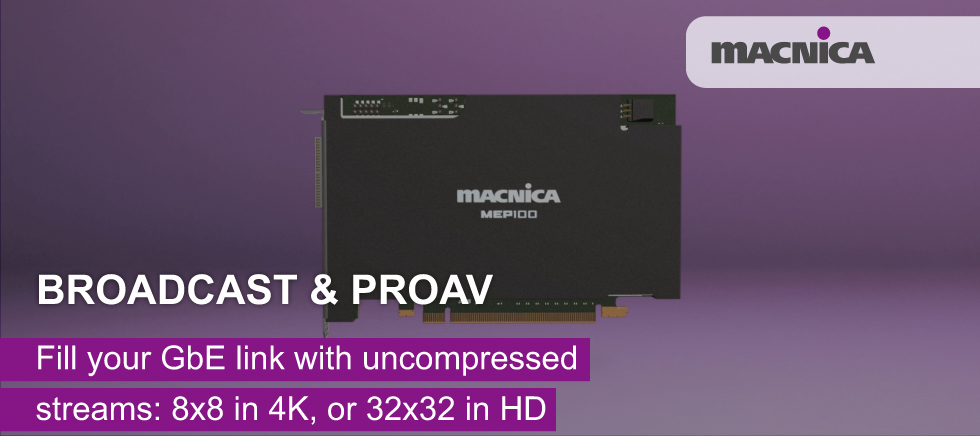Transforming Medical Video Transmission with ST 2110 and the Macnica MEP100
In today’s hospitals and medical schools, the ability to transmit live video isn’t just a technical convenience - it has become a vital tool for patient care, surgical precision, and medical education. From enabling specialists to support operating room teams in real time, to allowing hundreds of students to observe a complex surgery from a lecture hall, live video brings the operating theater to wherever it’s needed most.
The Power of Real-Time Surgical Video
During intricate surgical procedures, having the right eyes on the case can make all the difference. Live video transmission allows additional medical staff, whether they are in another part of the hospital or at a partner institution across the country, to follow the operation as it happens. These remote observers can offer immediate feedback or guidance, all without entering the sterile environment. This not only improves collaboration, but also reduces crowding in the operating room, lowering the risk of infection and distraction. For medical schools, live video transmission opens up an entirely new way to teach. Rather than limiting observation to a small number of people physically present, universities can stream procedures into lecture halls filled with students. High-definition imaging allows every student to see the fine details of surgical technique, while interactive audio links let them ask questions and receive answers in real time - something that would be impossible in a packed operating room.
SMPTE ST 2110: A Broadcast Standard in a Medical Setting
The quality and reliability of these live video links are critical. This is where SMPTE ST 2110 comes in. Originally developed for professional broadcast, ST 2110 is now referenced in the DICOM standard - the global framework for medical imaging - as a recognized protocol for medical video transmission. ST 2110 supports the transport of uncompressed, high-fidelity video over standard IP networks. In surgical imaging, this matters because every pixel counts. Whether magnifying delicate nerve fibers in neurosurgery or tracking the tiniest blood vessels in ophthalmology, any compression artifact can obscure critical detail. Beyond image quality, ST 2110’s architecture allows video, audio, and metadata to travel as separate but perfectly synchronized streams. In practice, that means a teaching theater could display the surgeon’s camera feed alongside a real-time patient vital signs overlay, or a remote expert could receive both the video and surgical navigation data without them ever drifting out of sync. And because ST 2110 runs over standard Ethernet, hospitals can scale their video networks without the need for expensive proprietary cabling.
The MEP100: Taking Medical Video Networking Further
While ST 2110 sets the foundation for interoperable, high-quality video, the Macnica MEP100 SmartNIC delivers the performance, reliability, and scalability to make these systems practical in a hospital environment. The MEP100 is designed to handle ST 2110 video in hardware, offloading all packetization, depacketization, and Precision Time Protocol (PTP) synchronization from the server’s CPU. This means a single server can handle multiple ultra-high-definition surgical feeds without sacrificing the computing power needed for other critical tasks, such as AI-driven image analysis or DICOM archiving. Latency is another crucial factor. In surgery, even a fraction of a second’s delay can impact decision-making. The MEP100’s kernel-bypass architecture ensures sub-frame latency, so what appears on a monitor in the lecture hall or a remote consultation room is virtually identical in timing to what the surgeon sees in the operating room. The card also supports ST 2022-7 hitless protection switching, which sends identical streams along two separate network paths. If one path fails, the other takes over instantly without a single dropped frame - an essential safeguard for mission-critical surgical video. In addition, the MEP100 can carry multiple synchronized streams, allowing hospitals to combine camera feeds, endoscope outputs, patient telemetry, and surgical navigation overlays into a single coordinated package. Once captured, these streams can be integrated into DICOM-compliant PACS systems for storage, retrieval, and later review.
A Real-World Example
Consider a teaching hospital performing a complex neurosurgical procedure. A surgical microscope’s 4K feed is routed to a server equipped with an MEP100 SmartNIC. The MEP100 processes the video in hardware, synchronizes it with patient monitoring data, and transmits it over the hospital’s IP network using ST 2110, with redundancy provided by ST 2022-7. In the main lecture theater, students watch the procedure in real time, complete with overlays showing critical patient vitals. Meanwhile, a specialist located in another city views the same feed and provides live consultation via a secure link. Once the surgery concludes, the entire recording is archived into the hospital’s DICOM system, ready to be used as a teaching resource for years to come.
A New Standard for Medical Video
By combining the interoperability and fidelity of ST 2110 with the performance and reliability of the MEP100 SmartNIC, hospitals and medical schools can build a live video infrastructure that is robust enough for surgery, flexible enough for teaching, and fully compatible with modern medical imaging standards. The result is a system that enhances collaboration, improves education, and ultimately helps deliver better patient outcomes.
Contact Macnica today to learn how the MEP100 SmartNIC and ST 2110-based solutions can bring broadcast-grade, real-time video networking to your hospital or medical school - transforming the way you teach, collaborate, and care for patients.







